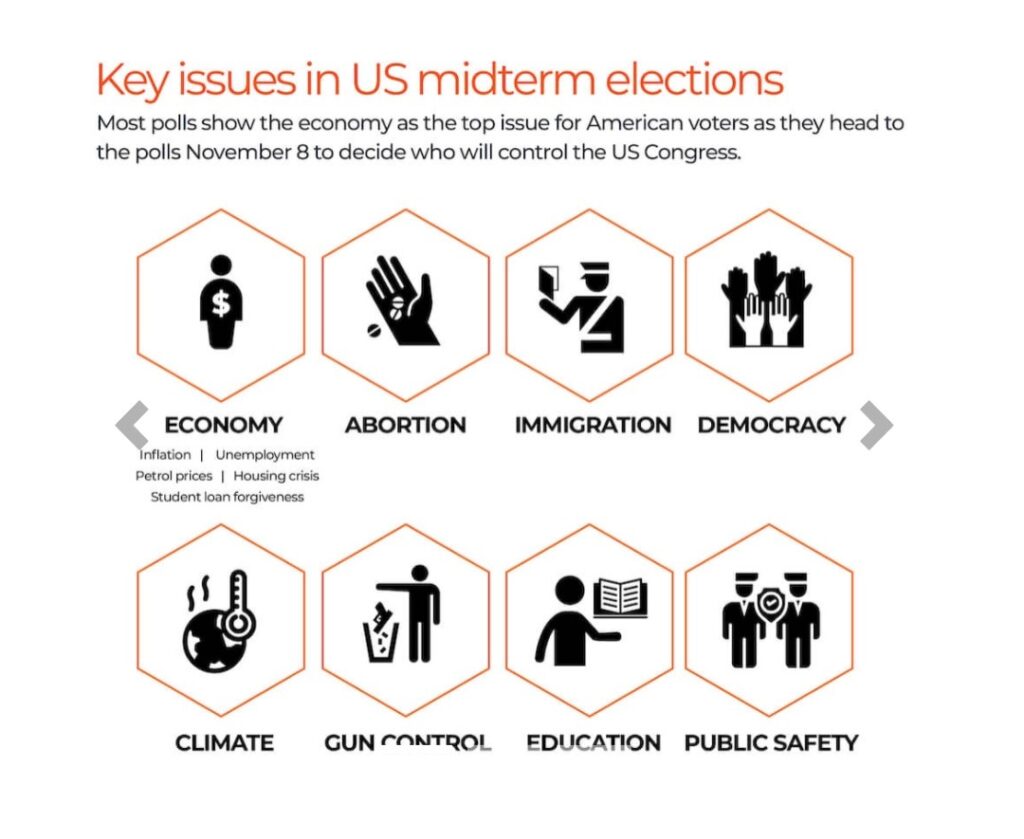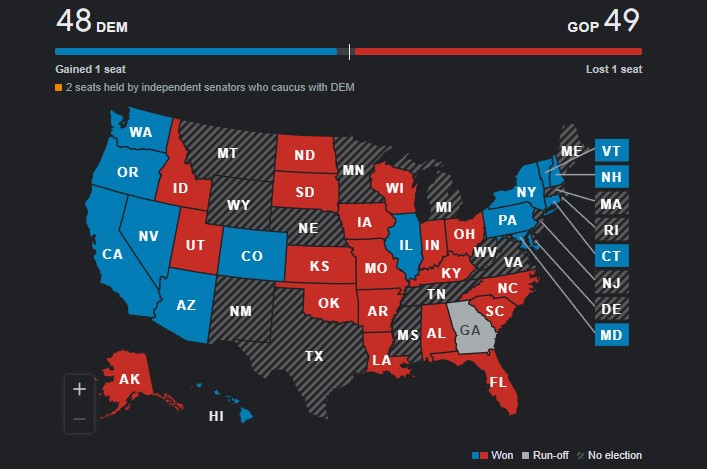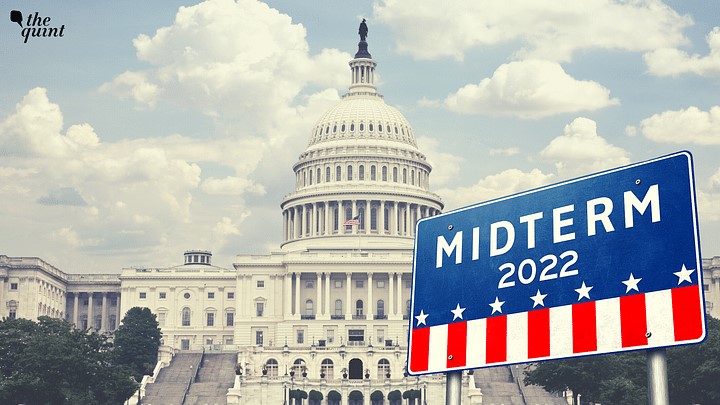Approximately halfway through a president’s four-year term in office, the United States holds midterm elections, which are general elections held on Election Day, the Tuesday after the first Monday in November. During the midterm elections, candidates are running for all 435 seats in the US House of Representatives, as well as 33 or 34 of the 100 seats in the US Senate.
While 34 of the 50 U.S. states elect their governors to four-year terms during midterm elections, Vermont and New Hampshire elect their governors to two-year terms in both midterm and presidential elections. Thus, 36 governors are chosen during midterm elections. Many states also elect officials to their state legislatures during midterm election years.

The 435 members of the House of Representatives, sometimes known as the House, are chosen every two years. The Senate, on the other hand, has 100 members who each hold a six-year term. All 435 seats in the House will be up for election because members of the House serve two-year terms. On the other side, elections will also be held for 34 Senate seats, or one-third of the Senate. The House of Representatives and the Senate, the two chambers of the US Congress, are up for election in the midterm elections.
The midterm elections are referred to as such because they take place every two years, falling in the middle of the president’s four-year tenure. All seats in the House of Representatives and one-third of the Senate are up for election in these elections. This implies that 35 of the 100 Senate seats and all 435 House of Representatives seats will be up for election.
The outcomes and early trends from the recently completed US midterm elections indicate a competitive Congress for the remainder of President Biden’s tenure. Republicans are likely to hold a majority in the House of Representatives while the Democrats appear poised to have won razor-thin control of the Senate. Consolidating Democratic control of the Senate will depend on the outcome of the last run-off in the state of Georgia.
Depending on the outcome, the Senate could have a 50-50 split between the two parties or a 51-49 vote in favour of the Democrats, who are supported by two independent candidates. The outcomes are viewed as being somewhat in the Democrats’ favour. However, if the most closely watched state election, in which Republican Mehmet Oz was defeated by Democrat John Fetterman, was a microcosm of the political fervour of the midterm elections, Democratic Representative from Ohio Tim Ryan’s defeat to Republican J.D.
Vance in the Senate race was the promise of continued support for the Republicans, which may well result in politically charged national elections in 2024. The Democrats are in a strong position to persuade voters to support their legislative objectives in the run-up to the 2024 presidential elections thanks to their control of the Senate and the absence of the Republican Party’s projected complete electoral sweep.

Republican division and the DeSantis factor
The victory of Florida Governor Ron DeSantis, however, was a bright spot for the Republicans in the midterm elections. Although it currently seems premature to identify the eventual Republican presidential candidate for the 2024 general elections, Ron DeSantis’ victory has undoubtedly increased the pool of potential candidates. Although Ron DeSantis has not yet publicly expressed any interest in seeking the Republican Party’s presidential candidacy for the 2024 elections, this is expected to change. According to a new poll, more people want DeSantis to be the Republican nominee in 2024.
The majority of the candidates backed by former President Donald Trump, on the other hand, have either lost or are in the backseat in this year’s midterm elections. For instance, in Pennsylvania, John Fetterman defeated Mehmet Oz; in Michigan, Gretchen Whitmer defeated Republican Tudor Dixon to win a second term as governor; and in Arizona, Blake Masters is trailing his Democratic opponent Mark Kelly in the fight for the Senate. The Trump-backed candidate Kari Lake isn’t doing well in the Democratic and Republican parties’ contest for governor of the same state.
DeSantis has been forced to declare his political ambitions, i.e., whether he will run for the Republican party’s presidential candidate in 2024, after being cornered by former president Donald Trump.

If Ron DeSantis wins with ease, it may well solidify his status as the party’s leader over other candidates. Importantly, that might place him against Donald Trump in the race to be the Republican Party’s nominee for president. For the Republican party, Ron DeSantis’ ascent has both positive and negative effects. On the plus side, Donald Trump may be inspiring the Republican Party to seek a new political renaissance and recapture some of the ground it has lost in the US political landscape.
Within the Republican Party, minimizing disagreements and preserving unity continue to be challenges. The midterm elections have, if anything, demonstrated that the GOP cannot only rely on Trump’s support. The midterm results have the potential to further splinter the Republican party by putting Donald Trump and Ron DeSantis on a collision course. Already, the Republican party is seeing two important phenomena that do not indicate a political consensus among its members.
DeSantis has been forced to declare his political goals, i.e., if he will compete for the Republican party’s presidential candidate in 2024, after being cornered by former president Donald Trump. In a related event, Trump blamed Mitch McConnell, the House minority leader from Kentucky, for the Republican Party’s midterm defeats. Donald Trump has publicly stated his desire to unseat Mitch McConnell from the post he has held since 2007 as the leader of the Republicans in the House as he seeks for re-election. Given that DeSantis and McConnell continue to enjoy widespread Republican support in both cases, these differences within the party are likely to isolate Trump and his decisions.
Republican House majority
The political agenda of the Biden administration would be slowed considerably in the event if the Republicans took control of the House. Republicans might also start looking into issues with President Biden and his family. Hunter Biden, the son of President Biden, will likely be the subject of an investigation by the House Oversight Committee now that it is in control of the chamber. Investigations could focus on his relationships with a Ukrainian oil business while Joe Biden served as vice president of the nation, the infamous Hunter Biden laptop incident, or even Hunter Biden’s private life. With these inquiries, the Republicans are hoping to bring President Biden to justice.

The US midterm elections were anticipated to have significant international repercussions for the US’s support of Ukraine against Russia. A Congress that is bitterly divided could jeopardise Washington’s financial and material backing for Ukraine. With their majority in the House, the Republicans are anticipated to impose greater checks and balances on the Biden administration’s wartime support to Ukraine.
The Republicans’ efforts to create a home narrative opposing prolonged substantial financial aid to Ukraine have been aided by the US’s high inflation rate. The US may have pushed Ukraine to restart talks with Russia as a result of growing domestic inflationary pressure on Biden and the absence of a House majority. It may have been fortuitous for the Biden administration that Ukrainian successes and the Russian withdrawal from Kherson occurred at the same time that the Republicans took control of the House.

The Republican and Democratic parties still control one chamber of Congress, despite the Democrats appearing to have escaped a Republican “Red Wave” takeover. The US post-midterm election period typically heralds the start of the presidential election season. The US is prepared for high-stress national elections in 2024.
Written by- Nidhi Shah
Edited by- Mehak Vohra




